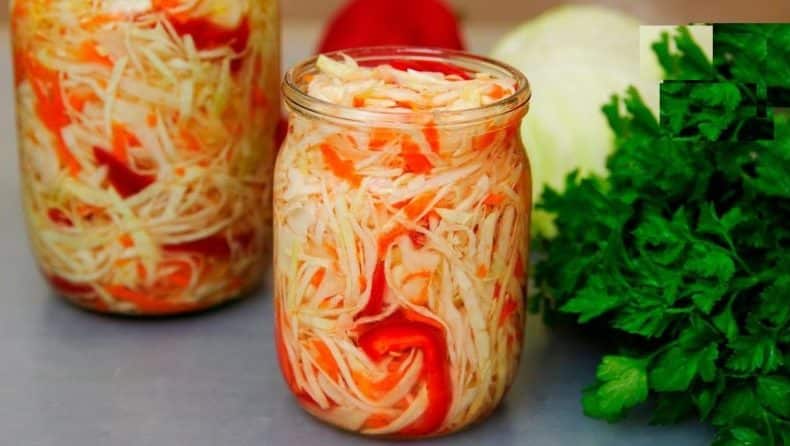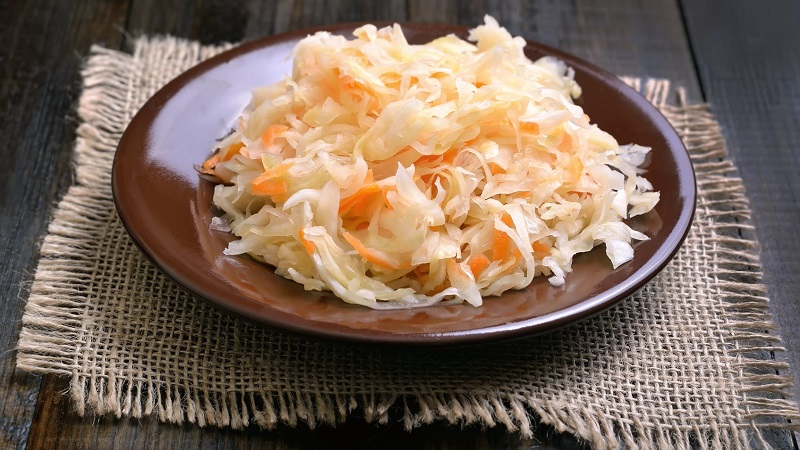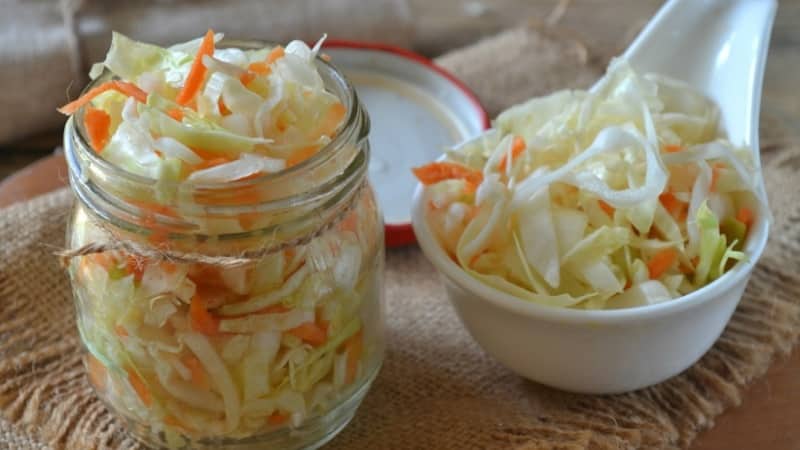Simple and tasty recipes for making sauerkraut with vinegar
Sauerkraut is a low-calorie product rich in vitamins, minerals and dietary fiber. During the fermentation process, the number of beneficial microorganisms in the vegetable increases, which normalize the functioning of the digestive system. Vinegar is added to the dish as a preservative; it increases the shelf life of the product.
Selecting and preparing cabbage
This is the first and extremely important stage of cooking.
Listen to the advice of experienced chefs:
- Only late or mid-season varieties are suitable, so you should not buy cabbage in the summer or early autumn for pickling. It is better to take heads of cabbage cut after the first frost.
- The following varieties and hybrids are suitable for self-cultivation: Belorusskaya 455, Slava, Moskovskaya late, Podarok, Countess F1, Kamennaya Golova, Valentina F1, Garant F1, Triumph F1.
- The larger the heads of cabbage, the better. The weight of one should be from 1 kg and above.
- It is advisable to take the fork in your hands and squeeze it well. If it is hard, does not shrink, does not lose its shape, it is a late variety. If soft, shrinks - early.
- All leaves, except the top one, should be white. Dark spots, streaks and damage indicate the presence of pests and deterioration.
- If possible, try the vegetable: suitable cabbage is sweetish, without bitterness and juicy.
Start preparing the snack immediately so that the heads of cabbage do not wilt and lose their benefits. The top leaves are removed and the cabbage is thoroughly washed.
Important! When the vegetable is cut, the stalk is removed: dangerous nitrates accumulate in it.

Benefits and harms of the product
Sauerkraut is a source of many vitamins, macro- and microelements:
- vitamin C helps cope with colds;
- vitamin K strengthens bone tissue and kidneys;
- B vitamins improve the functioning of the nervous system and memory;
- fiber and lactic acid bacteria normalize the gastrointestinal tract;
- sodium and potassium maintain water and acid-base balances.
Harm from sauerkraut will occur if you eat it on an empty stomach: the product increases acidity in the stomach, which contributes to the development of various gastrointestinal diseases.
It is not recommended to consume this dish at night: high risk of flatulence, heartburn, nausea.
Eating snacks is contraindicated if:
- hypertension: salt in the composition increases blood pressure;
- exacerbation of gastrointestinal diseases: cabbage increases acidity, which can only cause harm;
- exacerbation of kidney diseases;
- bloating: as a fermentation product, the vegetable only contributes to this.
How to leaven
Sauerkraut with the addition of vinegar is easy and quick to prepare; it will appeal to lovers of a sharper and sour taste.
Ingredients for the classic recipe:
- 1 large head of cabbage (about 2 kg);
- 2 medium carrots;
- 8 tbsp. l. 9% vinegar;
- 1 liter of cold water;
- 2 tbsp. l. table salt;
- 4 tbsp. l. Sahara.
Preparation:
- Remove the top leaves of the head of cabbage (including damaged ones) and wash the vegetable. Shred by hand or using a food processor.
- Coarsely grate the carrots.
- Mix the vegetables and put them in a prepared container: it is better to use glass or clay dishes.
- Prepare the marinade: pour water into a small saucepan, add salt and sugar, put on fire and bring to a boil.Then remove from heat, pour in vinegar and mix well.
- Pour the hot marinade over the cabbage and place in a warm place for a day. Then put it in the refrigerator. The product is better chilled.
Recipe Variations
There are many different recipes, both with and without vinegar, with the addition of berries, fruits and other vegetables. Below we consider common and simple options.

Instant salted cabbage
The name of the recipe speaks for itself: such an appetizer will be ready very quickly, and the taste will be piquant thanks to garlic, bay leaf, pepper and vinegar.
Ingredients:
- 1 kg cabbage;
- 1 carrot weighing 100 g;
- 3 cloves of garlic;
- 600 ml hot water;
- 1-2 bay leaves;
- 100 g sugar;
- 30 g salt;
- 125 ml 6% vinegar;
- peppercorns - optional.
Preparation:
- Chop the head of cabbage, grate the carrots and garlic. Mix everything, put it in a saucepan with the ability to put pressure on it.
- Place bay leaf, salt and sugar in a deep plate, add boiling water, mix well, add vinegar. Mix everything again.
- Pour the brine over the prepared vegetables, stir and place a weight of plate and weight on top (a large bottle of water will do). Place in a warm place for 2 hours.
- Remove the pressure and place the container with a lid in the refrigerator for 30–40 minutes.
With carrots and sugar

The addition of carrots gives the dish a slight sweetness, a beautiful color and additionally saturates it with vitamins. Sugar promotes better fermentation.
You will need:
- 1 kg of cabbage (without stalk);
- 200 g carrots (1-2 pcs.);
- 100–150 g sugar (depending on desired sweetness);
- 1 liter of boiled chilled water;
- 2 tbsp. l. salt.
How to cook:
- Cut the forks, grate the carrots, put them in one bowl, add salt and mix.
- Prepare a container for fermentation, place the vegetables in it without compacting it.
- Fill the food with water until it is 5 cm higher.
- Place the workpiece for 2-3 days in a dark place at room temperature.
- Several times a day, pierce the cabbage with a stick or fork to release gases.
- After 2-3 days, drain the juice, add sugar to it, stir until completely dissolved and refill the snack with brine.
- Place in the refrigerator or basement for 8–10 hours. Then serve.
With butter
Adding vegetable oil (sunflower, olive, corn) will give the snack a special flavor and improve the absorption of provitamin A.
Ingredients:
- 1 kg chopped cabbage;
- 100 g carrots;
- 2-3 garlic cloves;
- 2 tbsp. l. honey or 4-5 tbsp. l. Sahara;
- 500 ml water;
- 20 g salt;
- 50 ml vegetable oil;
- 50 ml 9% vinegar.
Preparation:
- Place the chopped vegetables in a deep bowl and mix.
- Pour water into a small saucepan, add salt, put on fire. When it boils, add oil and boil for 1 minute, turn off the heat. Add vinegar, honey or sugar. Mix everything thoroughly.
- Pour the hot marinade over the vegetables, mix gently, cover and let stand for 2-3 hours at room temperature.
Cool the appetizer before serving.
Reference! When fermenting, cabbage is not crushed so that it is crispy.
With apple cider vinegar
Apple cider vinegar has a special aroma and natural composition; together with cabbage, it restores the intestinal microflora.
For salting you will need:
- 1 liter of water;
- 700 g cabbage;
- 150 g carrots;
- 1 tsp. Sahara;
- 1 tbsp. l. salt;
- 3 tbsp. l. apple cider vinegar 6%.
Preparation:
- Add salt and sugar to boiling water and stir. Remove from heat, let cool.
- Chop the forks and carrots in a convenient way, put them in a deep bowl, mix and pour in the cooled brine.
- Add apple cider vinegar, mix gently and place in a container for fermentation.
- Cover and refrigerate for 20–24 hours.
With beets
The root vegetable will give the preparation a beautiful pink color and pleasant sweetness, and will also complement the dish with fiber and vitamins.
Ingredients:
- 3 kg cabbage;
- 1 kg beets;
- 300 g carrots;
- 3 tbsp. l. salt.
Preparation:
- Cut the head of cabbage into pieces about 5 mm thick. Coarsely grate carrots and beets.
- Place the vegetables in a deep bowl and add salt.
- Knead with your hands until it comes out juice and the vegetables will not be covered with it.
- Cover the workpiece with a plate and apply pressure.
- Place the container in a warm place for 4-5 hours, then in the refrigerator for 3 days.
Storage Features

The ideal place to store sauerkraut is a cellar or basement, since the temperature here is the most suitable: 0…+4°C. The product will keep indoors until next summer.
If there is no such storage, a refrigerator will do. However, you won’t be able to save a lot of cabbage; it will be stored there for 1–1.5 months, since the temperature in the refrigerator is +5…+6°C.
Advice! If there is a temperature setting function, set the temperature to +4°C.
On a glazed balcony it is important that the temperature does not drop below 0°C. When it freezes, containers with cabbage are insulated with warm clothes and placed on a pallet. In such conditions, the preparations are left throughout the winter and spring.
At room temperature, the snack will ferment, begin to sour and quickly spoil. Therefore, this storage method is not suitable.
Vegetables if necessary freeze up to 8 months. After defrosting, consume immediately.
The recommended container for pickling and storing cabbage is glass. A more suitable option is a wooden barrel, but it will require a lot of free space. Some housewives use plastic containers with lids, enamel buckets or pans without chips.
Adviсe
Experienced housewives recommend:
- Do not overcook cabbage at room temperature, otherwise it will ferment and lose the desired taste.
- Do not add iodized salt to the snack: it inhibits fermentation.
- Follow the proportions in the recipe and use only proven instructions so as not to spoil the products.
- Keep vegetables under brine while cooking.
Conclusion
This selection of delicious and quick recipes will help you prepare a popular winter snack. They experiment with ingredients and their quantities to create a special dish. Sauerkraut goes well with meat and potatoes, and is suitable for soups and salads.